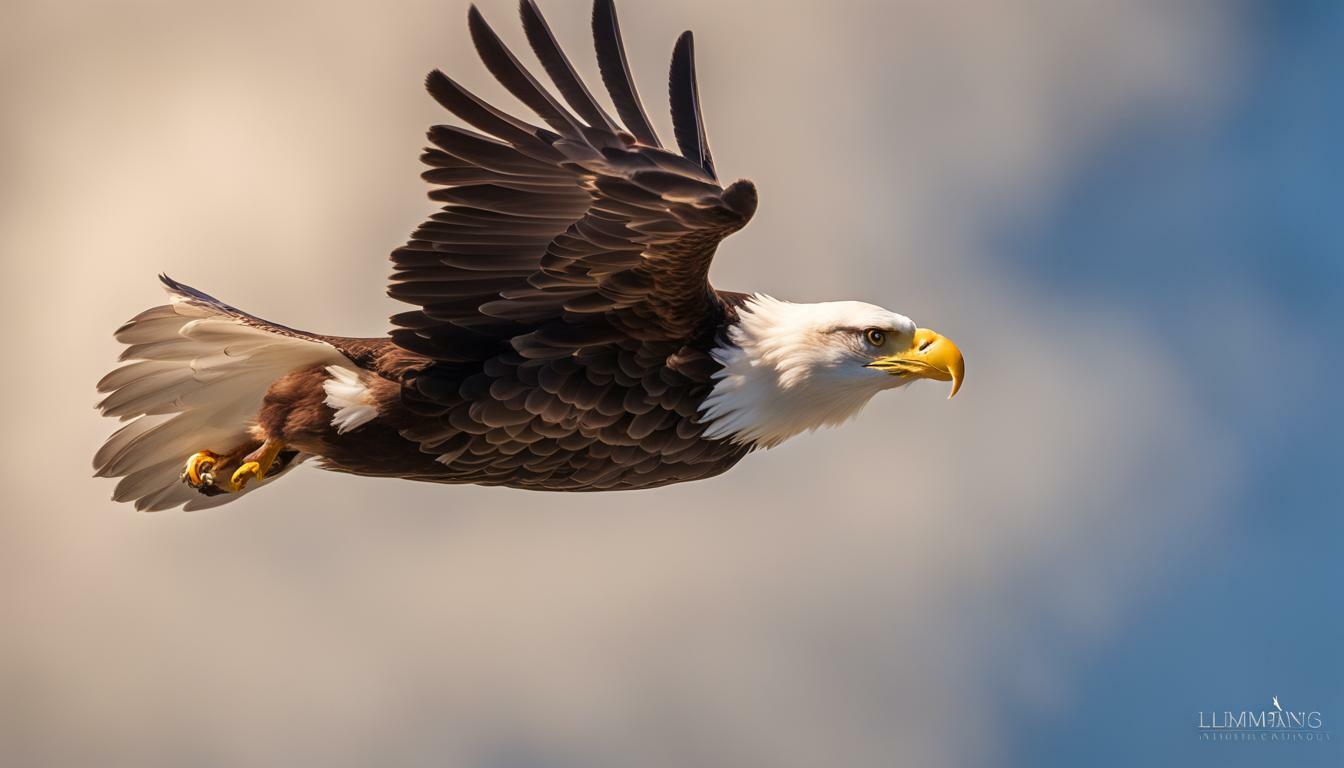Have you ever wondered how fast a bald eagle can dive to snatch its prey? These majestic birds of prey are known for their impressive hunting abilities and speed, making them a symbol of power and freedom in the United States. In this article, we’ll take a closer look at the physical characteristics and hunting techniques of bald eagles, and explore the factors that affect their diving speed.
Key Takeaways:
- Bald eagles are known for their impressive hunting abilities and speed.
- We’ll explore the physical characteristics and hunting techniques of bald eagles, and the factors that affect their diving speed.
Introduction to the Bald Eagle’s Diving Ability
Have you ever wondered how fast a bald eagle can dive? As one of the largest birds of prey in North America, the bald eagle is known for its impressive ability to catch fish in its sharp talons while soaring high above the water. But it’s not just their keen eyesight and powerful talons that make them such skilled hunters. The bald eagle is also capable of diving at incredible speeds to catch their prey.
In this article, we’ll take a closer look at the bald eagle’s diving ability, examining its physical characteristics, hunting techniques, and the factors that affect its diving speed. We’ll also explore the latest research and observations on bald eagle dives, including the fastest recorded dive speed. By the end of this article, you’ll have a greater understanding of what makes the bald eagle such an impressive bird of prey.
Physical Characteristics of Bald Eagles
Bald eagles are one of the largest birds of prey in North America, weighing up to 14 pounds and having a wingspan of up to 7 feet. Their sharp talons, curved beak and powerful wings make them well adapted for hunting and flying at high speeds.
Unlike other birds, eagles have a special transparent nictitating membrane that protects their eyes while hunting underwater prey. They also have a unique musculoskeletal system that allows them to close their talons with an incredible force of about 400 pounds per square inch.
| Physical Characteristics | Description |
|---|---|
| Weight | Up to 14 pounds |
| Wingspan | Up to 7 feet |
| Talons | Sharp and strong, with a force of 400 pounds per square inch |
| Beak | Curved and sharp, used for tearing prey apart |
These physical characteristics, combined with their exceptional eyesight and agility, make bald eagles one of the most skilled hunters in the animal kingdom.
Hunting Techniques of Bald Eagles
As a bird of prey, the bald eagle has evolved with natural hunting instincts that allow it to thrive in its environment. When hunting, bald eagles use a variety of techniques that are unique to their species. Their natural hunting instincts, combined with their impressive physical characteristics, make them one of the most efficient predators in the animal kingdom.
Spotting Prey
Bald eagles have excellent eyesight, which allows them to spot prey from a great distance. Their eyesight is so sharp that they can see fish swimming underwater from a height of several hundred feet. Once they spot their prey, they will use their long, sharp talons to grasp it.
Diving Technique
One of the most impressive hunting techniques of bald eagles is their ability to dive at high speeds to catch their prey. When they locate a fish, they will fly at a high altitude and then dive toward the water. During the dive, they close their wings to streamline their body and reach speeds of up to 100 miles per hour. Just before they hit the water, they will extend their talons and grab the fish with their sharp claws.
Using the Element of Surprise
Bald eagles also use the element of surprise to catch their prey. They will often perch on a tree limb or rock and wait for an unsuspecting fish to swim by. When the fish is within range, the eagle will swoop down and grab it with its talons. This technique is particularly effective in shallow water, where the fish may not see the eagle until it’s too late.
Collaborating with Other Eagles
Bald eagles have also been known to collaborate with other eagles when hunting. They may work together to corner a school of fish, making it easier for each eagle to catch its share. This collaborative hunting technique is impressive and demonstrates the intelligence of these majestic birds.
Factors Affecting the Bald Eagle’s Diving Speed
The diving speed of a bald eagle is not only influenced by its body structure but also by various environmental factors. Here are some of the significant factors that affect the speed of a bald eagle’s dive:
- Height of the dive: The height of the dive determines the speed of the bald eagle’s descent. Bald eagles usually dive from a height of 30 to 60 feet.
- Angle of the dive: The angle of the dive also plays a crucial role in determining the speed of the bald eagle’s dive. Bald eagles tend to dive at an angle of around 45 degrees, which allows them to maintain high speeds while also keeping a clear view of their prey.
- Wind speed and direction: Strong winds can either help or hinder the bald eagle’s speed, depending on the direction of the wind. Tailwinds can increase the speed of the bald eagle’s dive, while headwinds can slow it down.
- Water depth: The depth of the water can impact the bald eagle’s speed, as it affects the angle and trajectory of their dive. Bald eagles tend to dive into shallow waters to avoid drowning.
- Prey size: The size of the prey also affects the bald eagle’s diving speed. Smaller prey requires a quicker and more precise dive, while larger prey may require a slower dive to maintain control.
Understanding these factors can help in predicting the speed and accuracy of a bald eagle’s dive. Other factors such as age, experience, and overall health can also affect the bald eagle’s diving speed and should be taken into consideration.
Understanding the Speed of Bald Eagle Dives
Now that you know some of the physical characteristics and hunting techniques of bald eagles, it’s time to delve deeper into their diving speed.
Several factors can affect the speed at which a bald eagle dives. Some of these factors include the bird’s altitude, the angle at which it dives, wind conditions, and the location of the prey.
When diving, bald eagles can reach speeds of up to 100 miles per hour. That’s faster than a cheetah runs on land! Their sharp talons can grip prey with a force of up to 400 pounds per square inch.
Observations and studies have shown that bald eagles tend to dive faster when hunting for fish than when hunting for other prey, such as mammals or birds. This is because fish are often closer to the surface of the water, which allows eagles to dive at steeper angles and reach faster speeds.
It’s important to note that not all bald eagles are the same, and their diving speeds can vary depending on their age, sex, and individual abilities. However, on average, bald eagles are incredibly fast and efficient hunters.
Observations and Studies on Bald Eagle Diving Speed
Scientists have conducted numerous studies to measure the diving speed of bald eagles. These studies have involved placing sensors on eagles to track their movements and using high-speed cameras to capture their dives in action.
One such study was conducted by National Geographic in collaboration with the US Fish and Wildlife Service. They found that bald eagles can reach speeds of up to 100 miles per hour (160 kilometers per hour) when diving to catch prey.
Another study conducted by researchers at the University of Florida found that the shape of eagle’s wings plays a crucial role in their ability to dive at high speeds. The study found that eagles with longer, more pointed wings were able to achieve higher diving speeds than those with shorter, broader wings.
Furthermore, researchers at the University of Minnesota have studied the effects of wind resistance on bald eagle diving speeds. They found that wind resistance can significantly slow down an eagle’s dive, especially when diving against strong headwinds.
Studies on Bald Eagle Visual Perception
Aside from physical characteristics and environmental factors, scientists have also studied the visual perception of bald eagles to determine how they locate and track prey while diving.
Research conducted at the University of California, Santa Cruz found that bald eagles have a unique visual system that allows them to see prey from great distances while flying at high speeds. The study found that bald eagles have a higher density of photoreceptors in their eyes than humans, allowing them to detect small movements from miles away.
This impressive visual acuity is further enhanced by the eagle’s ability to rapidly adjust the shape of their pupils to allow more light into their eyes while diving, giving them a clearer view of their prey.
Fastest Recorded Bald Eagle Diving Speed
Several studies have been conducted to determine the speed of a bald eagle’s dive, and the fastest recorded speed is 120 miles per hour (193 km/h). This astonishing speed was recorded in a study conducted in Alaska, where bald eagles are known for their exceptional diving ability.
| Study Location | Fastest Recorded Speed |
|---|---|
| Alaska | 120 mph (193 km/h) |
| Florida | 99 mph (159 km/h) |
| Michigan | 75 mph (120 km/h) |
It’s important to note that the speed of a bald eagle’s dive can vary depending on various factors, such as the angle and height of the dive, and the wind speed. These factors can either increase or decrease the speed of the dive.
Despite the impressive speed, a bald eagle’s dive is not the fastest among birds of prey. The peregrine falcon holds the world record for the fastest animal in a dive, reaching speeds of up to 240 mph (386 km/h).
However, the bald eagle’s diving ability is still remarkable and unique. Its large body size and strong talons allow it to grab prey with great force, making it one of the most effective hunters among birds of prey.
Comparing Bald Eagle’s Diving Speed to Other Birds of Prey
While the bald eagle is one of the largest birds of prey in North America, it is not the fastest. The peregrine falcon holds the title of the fastest bird in the world, with diving speeds reaching up to 240 miles per hour! The gyrfalcon and golden eagle also surpass the bald eagle in terms of speed, reaching diving speeds of up to 130 miles per hour and 200 miles per hour, respectively.
However, the bald eagle’s diving speed of up to 100 miles per hour is still impressive, especially considering the bird’s size and weight. A bald eagle can weigh up to 14 pounds, while a peregrine falcon typically weighs around 2 pounds.
It’s important to note that the diving speed of a bird of prey can vary depending on various factors, such as the bird’s size, weight, and hunting techniques. The environment, weather conditions, and altitude can also affect the bird’s diving speed.
Overall, while the bald eagle may not hold the title for the fastest bird of prey, its diving ability is still awe-inspiring and a testament to the bird’s strength and agility.
Impressive Speed: What Makes the Bald Eagle’s Diving Capability Unique?
If you’re wondering what sets the bald eagle apart from other birds of prey, their diving speed might impress you. While there are many factors that contribute to the bald eagle’s sharp hunting skills, their ability to dive at incredible speeds is undoubtedly one of the most impressive.
Unlike other raptors that dive straight down to ambush their prey, bald eagles have a unique technique that makes them stand out. When hunting, they soar above the water and scan for prey. Once they spot a target, they tilt their bodies and drop with their wings tucked into a streamlined shape. As they dive, they can reach speeds of up to 120 miles per hour!
But what makes this diving capability unique? For one, the bald eagle’s keen eyesight plays a significant role in their hunting success. They can spot a fish swimming below the surface of the water from several hundred feet up. Their powerful talons and hooked beak also allow them to efficiently capture and carry their prey away.
Furthermore, the bald eagle’s ability to adjust their wings and tail during a dive enables them to maintain their balance and steer themselves towards their target. This precision and control are crucial when hunting in areas with strong currents or winds.
Overall, the combination of the bald eagle’s sharp vision, strong body, and agility during a dive makes their diving capability truly impressive and unique.
Conservation and Protection of Bald Eagles
The Bald Eagle is a magnificent bird of prey that holds deep cultural and symbolic significance in the United States. However, their population was once threatened due to hunting, habitat destruction, and the usage of DDT pesticides.
Thankfully, the Bald Eagle Protection Act of 1940 and the banning of DDT in the 1970s helped revive the population of Bald Eagles. Today, Bald Eagles are classified as a species of “least concern” by the International Union for Conservation of Nature (IUCN).
Even though they are no longer threatened, it is still crucial to protect and maintain the habitat of Bald Eagles. The conservation efforts help protect their prey, such as fish and small mammals. This is achieved through various methods such as habitat preservation, nest management, and regulating human activity near their nesting sites.
Furthermore, it is illegal to hunt, harm, or disturb Bald Eagles, their nests, or their eggs. If you spot someone violating these laws, you can report them to the United States Fish and Wildlife Service.
It is our responsibility to continue to protect and conserve these majestic creatures for future generations to enjoy and appreciate.
Conclusion: The Astonishing Speed of a Bald Eagle’s Dive
After learning about the physical characteristics, hunting techniques, and factors affecting the diving speed of bald eagles, you can appreciate the impressive capabilities of these majestic birds of prey. Their diving speed is truly astonishing, thanks to their streamlined bodies, strong wings, and sharp talons.
Observations and studies have shown that bald eagles can reach diving speeds of up to 100 miles per hour (160 km/h). This is faster than any other bird of prey and even faster than some airplanes during takeoff. It’s no wonder that bald eagles are considered one of the top predators in their ecosystem.
The fastest recorded bald eagle diving speed was 120 miles per hour (193 km/h) by a captive eagle named “Challenger” in 2005. This impressive feat was captured on camera and has been studied by scientists to better understand the mechanics of bald eagle dives.
Comparing their diving speed to other birds of prey, such as peregrine falcons and gyrfalcons, shows that bald eagles are unmatched in their diving capabilities. While these other birds can reach high speeds during their dives, they don’t come close to the speed and force of a bald eagle’s dive.
What makes the bald eagle’s diving capability unique is not just its speed, but its accuracy and power. Bald eagles have been observed diving into water to catch fish, but they can also dive onto land to catch prey or defend their territory. Their powerful talons can grip onto their prey with great force, making it difficult for them to escape.
As a symbol of American freedom and strength, bald eagles are protected by federal laws in the United States. Conservation efforts have helped to increase their populations, but they still face threats from habitat loss, pollution, and illegal hunting.
In conclusion,
the bald eagle’s diving speed is truly remarkable and a testament to their remarkable adaptations for survival. Watching a bald eagle dive is a sight to behold, and one can only imagine the thrill of experiencing it firsthand. Protecting these amazing creatures and their habitats is crucial to ensuring their continued existence for future generations to enjoy.
Can Bald Eagles Fly at High Speeds?
Bald eagles are exceptional flyers, demonstrating their agility and strength in the sky. With a wingspan of approximately 7 feet, they can reach impressive speeds of up to 40 miles per hour. However, when they engage in a hunting stoop, they can soar at exceptionally high speeds, such as 100 miles per hour or even faster. Consequently, showcasing their remarkable aerial prowess. So, it’s safe to say that how high can bald eagles fly is an inquiry that is complemented by their impressive speed and flight abilities.
FAQ
Q: How fast can a bald eagle dive?
A: A bald eagle can reach speeds of up to 100 miles per hour when diving.
Q: What is the purpose of a bald eagle’s dive?
A: Bald eagles dive primarily to catch fish, their main source of food.
Q: How do bald eagles spot their prey when diving?
A: Bald eagles have exceptional eyesight that allows them to spot fish from great heights.
Q: How do bald eagles protect themselves from injury when diving at high speeds?
A: Bald eagles have specially designed feathers and strong wings that help absorb the impact of their dives.
Q: Do all bald eagles dive at the same speed?
A: No, diving speed can vary among individual bald eagles depending on factors such as age, experience, and environmental conditions.
Q: How often do bald eagles dive?
A: Bald eagles typically dive when hunting for food, so the frequency of dives depends on their hunting success and prey availability.
Q: Are bald eagles the fastest birds of prey when diving?
A: While bald eagles are known for their impressive diving speed, there are other birds of prey that can dive even faster, such as the peregrine falcon.
Q: Can bald eagles dive from any height?
A: Bald eagles can dive from various heights, but they usually prefer to start their dives from elevated perches or tree branches.










